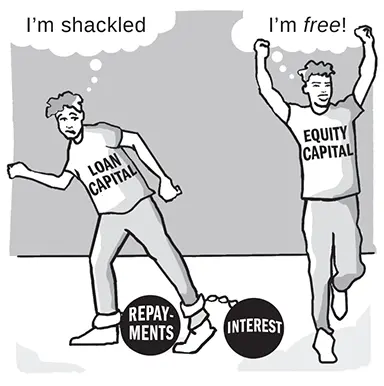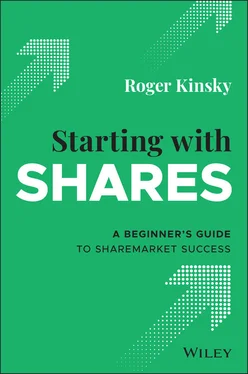Another way a business can raise a substantial amount of capital is by means of business loans with a bank or other financial institution. This capital is naturally enough known as loan capital . Two different types of loans are possible:
Short‐term loans: Almost all businesses operate with a certain amount of credit. For example, if the business purchases goods, it's not usually on a cash on delivery (COD) basis. Instead, suppliers and contractors usually allow a one to two month delay before payment is required. The money the business owes in this way is an example of a short‐term loan.
Long‐term loans: The amount of capital a business can obtain from short‐term loans and the length of time the capital is available is limited. If a business needs a substantial amount of capital and wants this capital to be available for a longer period, it can apply to a bank or financial institution for a business loan. This is very similar to a mortgage, where interest is charged on the loan monthly but the loan is repaid over the longer term, which could be around 20 years.
For a business, equity capital has a big advantage over loan capital. Can you think what this is?
The answer is that equity capital is ‘free’, because the business isn't required to pay any interest on the capital and the capital doesn't need to be repaid.

It might surprise you to learn that from a shareholder's point of view it's usually better that the business has a reasonable amount of loan capital rather than trying to operate entirely on equity capital. The reason for this is that the business can usually use the loan capital to obtain a higher return on the capital invested than the cost of the interest on the loan. For example, if a business pays 6% interest on its long‐term loan and can use this capital to generate a 10% profit, the business makes 4% clear profit on the loan capital and this benefits the shareholders.
Therefore, when a business has some loan capital, it doesn't need as much equity capital and so can have fewer shareholders — which, in turn, means that each shareholder benefits by getting a larger slice of the profit pie.
Although some loan capital is good, a business with too much loan capital is risky because it's vulnerable to downturns in business or the economy.
You can become a shareholder in a public company in two main ways: participating in a float or purchasing shares from someone else. I also cover some of the other, less common, ways of becoming a shareholder at the end of this section.
To participate in a float (or IPO) you need to get a copy of the prospectus and provide the information required. You may do this using a paper copy of the prospectus or you might be able to do it electronically. In any case, you'll need to provide some financial information such as bank account details. You may also need to give some security details to ensure you're a bona‐fide person and to prevent money laundering or tax evasion. Of course, you also have to pay for the shares you want. For example, if the issue price is $2.00 and you want 1000 shares, you'll have to cough up $2000. The float will have an expiry date and you need to make sure your application and application money are received before this date.

‘I want to get these new shares before they're listed.’
Subscribing to a float and getting shares this way is similar to buying a new commodity such as a new car or book. The item hasn't had a previous owner and is unused so should be in perfect condition.
Purchasing shares from someone else
Once a company has floated and its shares are available through the securities exchange, you can buy shares in it from someone who wants to sell them, using the exchange trading facility. In past times, share trading was like an auction with buyers and sellers making deals directly, but nowadays it's done by a computer.
Now here's the catch: you can't deal directly with the exchange because to do so you need to be approved and licensed by them. So before you can trade shares, you need to find a licensed dealer who'll act on your behalf. These licensed dealers are known as sharebrokers , stockbrokers or simply brokers .
Naturally, brokers charge a fee for service that's known as brokerage , and this fee can vary a fair bit. Because many brokers offer their services, competition is fierce. This competition means lower prices so brokerage isn't a significant cost. Although you needn't worry too much about brokerage, but I do discuss it in more detail in chapter 7, when I explain how you can trade shares.
Buying shares through an exchange is similar to buying a second‐hand commodity, such as a used car or used book. The shares have been pre‐owned and aren't brand new.

Buying used shares and buying any other used commodity differs in one important way. Can you think what it is?
The answer is that with any physical commodity such as cars, books or clothing, the item has been previously used and is likely to show wear and tear. Also the item can become outdated or out of fashion because a new model comes on to the market. For example, with a motor car, the number of kilometres and its age are key factors in determining the car's value. With shares, the age of the shares or the number of previous owners doesn't matter at all because these factors have no influence on the share price. Shares aren't a physical commodity and don't age or become outdated. In fact, with quality shares the price is far more likely to rise with time than to fall.
I discuss the nuts and bolts of how you can trade shares in chapter 7.
Other ways of becoming a shareholder
You can become a shareholder in other ways than the two already mentioned. Some of these are:
Inheritance: When a shareholder dies, the shares they own form part of their estate and will eventually be transferred to one or more of their beneficiaries. If you're one of those beneficiaries, the executors will arrange transfer of the shares into your name.
Private treaty: As with any other commodity, transfer of share ownership can be arranged by direct negotiation between buyer and seller. In Australia, several thousand different shares are tradeable, not to mention the rest of the world, so it's generally not feasible to negotiate trades by private treaty (although some really large share transfers are negotiated this way).
Privatisation: When the government decides to offload an asset, they usually do so by issuing shares. For example, Commonwealth Bank, Commonwealth Serum Laboratories, Qantas and Telstra were made available for public ownership in this way. Many Australians became shareholders by subscribing to the shares when they were first made available for purchase.
Structure change: Many Australians became shareholders when mutual companies and friendly societies changed structure and became public companies. This was the case with many insurance companies and co‐operative building societies.
Читать дальше















